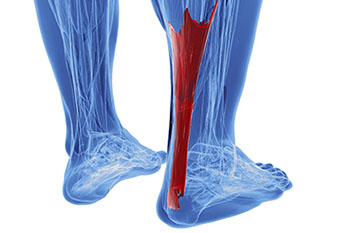Ankle
Ankle Pain

Ankle pain, while initially thought of as an issue for athletes, can affect anyone at any time. Simple, everyday activities, such as walking or running on an uneven surface, have the possibility of causing serious harm to one’s ankle. That is, however, not to discount athletic injuries; in fact, half of all ankle sprains are inflicted during an athletic activity. The most common causes of ankle injuries include tripping or falling, landing awkwardly after jumping, a sudden impact such as a car crash, or twisting, rolling, and rotating of the ankle.
Some signs that point to the potential of an ankle injury include pain towards the affected area, swelling, bruising, or an inability to walk or bear weight on the affected area. You may also notice an increase in the height of the arch of the inflicted foot. In order to understand why the injury occurred, a podiatrist will often question the patient about the events leading up to their ankle discomfort. An x-ray of the leg or foot may also be performed to discover what’s harming the ankle.
There are many different types of ankle injuries, such as ankle sprains, fractures, strains, and tendonitis. To relieve discomfort caused by these conditions, it’s recommended to get plenty of rest, use ice to reduce swelling and ease pain, compress the injured ankle by wrapping it for support, and elevate the ankle to reduce swelling.
If you or someone you know is experiencing pain or discomfort in the ankle region, seek out the help of a podiatrist for a proper diagnosis and treatment regime.
Ankle Sprains

Sprained ankles may occur when a person accidentally rolls, twists, or turns their ankle in an awkward way. When this occurs, ligaments in the ankle are being forced beyond their range of motion, thus causing an injury. Some symptoms that point to having a sprained ankle may include swelling, bruising, tenderness, and pain inflicted on the affected area. Some may also experience restricted range of motion or feel instability in the ankle.
There are many factors that play into the cause of ankle sprains. Simple, everyday activities like walking can lead to an ankle sprain if the activity is being done on an uneven surface. The same goes for running or exercising. Those who partake in sports may be more susceptible to obtaining a sprained ankle because they’re more likely to fall or land uncomfortably after a jump, which can lead to an injury.
It’s important to note that some of the main risk factors that can lead to sprained ankles are improper footwear, a prior ankle complication, weakness or lack of flexibility in the ankle region, and as mentioned above, uneven surfaces and involvement in sporting activities.
To better prevent an ankle sprain, it’s recommended to warm up before partaking in intense physical activities, use caution when walking or running on rough surfaces, consider using tape or wearing a brace on a previously injured ankle, and avoid frequently wearing footwear that puts tension on your ankles, like high heels.
In order to alleviate some discomfort caused by an ankle sprain, it’s recommended to get plenty of rest, try icing the affected area, keep the ankle elevated, and wrap or compress the ankle so it has little to no motion. For a professional diagnosis and information on treatments for a sprained ankle, consult with a podiatrist.
Achilles Tendon

The Achilles tendon is not only the strongest, but also the largest tendon in the human body. The main function of the Achilles tendon is to transmit power from the calf muscles to the heel and the foot.
It’s because of the Achilles tendon that we are able to stand on our toes when walking, running, or jumping. Even with all of its strength, the Achilles tendon can be exposed to injury. Due to its limited blood supply and the high tensions placed on it, the Achilles heel can be left vulnerable if harmed. Possible conditions that may arise due to injury of the Achilles tendon include tears, ruptures, tendinitis, peritendinitis, tendinosis, tendinopathy, and bursitis.
Foot and Ankle Fractures

When the foot or ankle experiences trauma, a fracture may occur. Causes of foot and ankle fractures can vary. In some cases, an obvious impact to the foot or a fall can be behind a fracture. Fractures can also occur because of increased stress on the bone over time. The location of the fracture can often give your podiatrist information on how the fracture occurred.
Pain, especially when bearing weight, is a telltale sign of a fracture. Limping due to this pain is a further sign of a foot or ankle fracture. Other symptoms include inflammation, bruising, deformity, and tenderness. A deformity may occur due to a shift in bone alignment or a joint dislocation near the fracture. While pain is a significant symptom of breakage, a patient who has nerve damage or who has diabetes may not feel this pain. In this instance, your podiatrist will look for additional signs to determine whether a fracture has occurred.
Foot and Ankle Surgery

When it comes to receiving foot and ankle surgery, it’s typically a case by case situation. Some factors that play a role in whether or not you need surgery include the severity of your symptoms as well as your response to other conservative, noninvasive treatment methods.
There are a number of different foot and ankle conditions that may benefit from surgery as a treatment option. Bunions, hammertoe, metatarsal, ankle arthritis, Achilles tendon disorders, Morton’s neuroma, tibialis posterior disorder, and plantar fasciitis are all conditions that may require surgery as a treatment option, depending on their severity. Long-lasting pain relief is typically the biggest takeaway from having surgery performed to remedy your condition.
If you’d like to determine whether surgery is the best option for you and your foot condition, consult with a podiatrist who will be able to give you a proper diagnosis and aid you with your decision.



